Faculty of Technology: Low Carbon Innovation and Transportation Report
VerifiedAdded on 2022/09/09
|18
|3649
|13
Report
AI Summary
This report delves into the realm of low carbon innovation within the transportation sector, highlighting the industry's vulnerability to climate change. It meticulously analyzes the regulatory and policy frameworks designed to combat climate change, while also exploring various innovation theories such as disruptive, incremental, and game-changing innovations. The report includes a management perspective, proposing disruptive technologies to mitigate business threats stemming from climate change. It investigates the characteristics of early adopters of innovative products and services, and examines ways in which innovation can curtail greenhouse gas emissions. The study offers insights into the strategies for sustainable transportation, including the role of government and private sector partnerships and the adoption of behavioral changes to complement technological advancements. The report concludes by summarizing key findings and providing recommendations for fostering low-carbon practices in transportation.
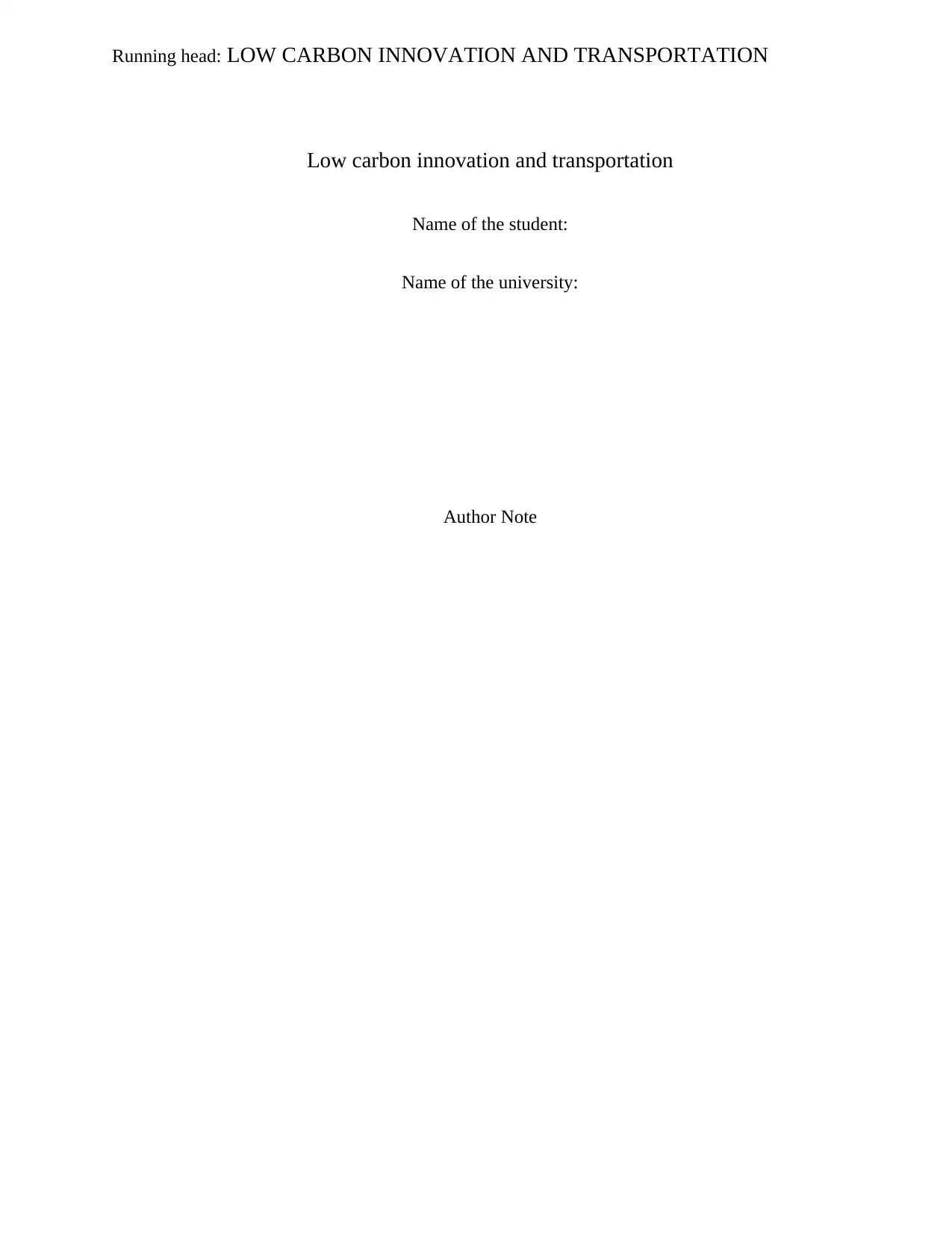
Running head: LOW CARBON INNOVATION AND TRANSPORTATION
Low carbon innovation and transportation
Name of the student:
Name of the university:
Author Note
Low carbon innovation and transportation
Name of the student:
Name of the university:
Author Note
Paraphrase This Document
Need a fresh take? Get an instant paraphrase of this document with our AI Paraphraser
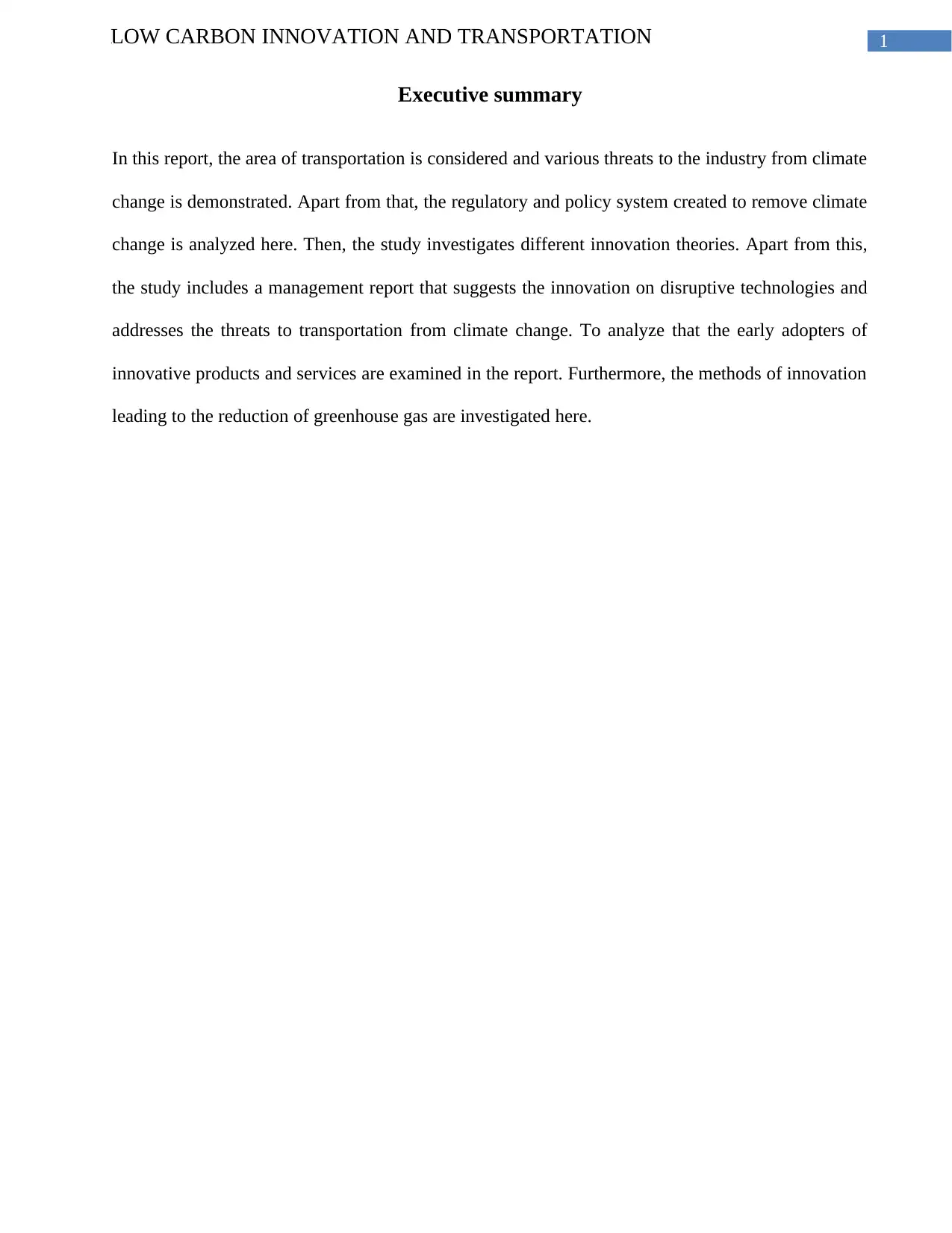
1LOW CARBON INNOVATION AND TRANSPORTATION
Executive summary
In this report, the area of transportation is considered and various threats to the industry from climate
change is demonstrated. Apart from that, the regulatory and policy system created to remove climate
change is analyzed here. Then, the study investigates different innovation theories. Apart from this,
the study includes a management report that suggests the innovation on disruptive technologies and
addresses the threats to transportation from climate change. To analyze that the early adopters of
innovative products and services are examined in the report. Furthermore, the methods of innovation
leading to the reduction of greenhouse gas are investigated here.
Executive summary
In this report, the area of transportation is considered and various threats to the industry from climate
change is demonstrated. Apart from that, the regulatory and policy system created to remove climate
change is analyzed here. Then, the study investigates different innovation theories. Apart from this,
the study includes a management report that suggests the innovation on disruptive technologies and
addresses the threats to transportation from climate change. To analyze that the early adopters of
innovative products and services are examined in the report. Furthermore, the methods of innovation
leading to the reduction of greenhouse gas are investigated here.
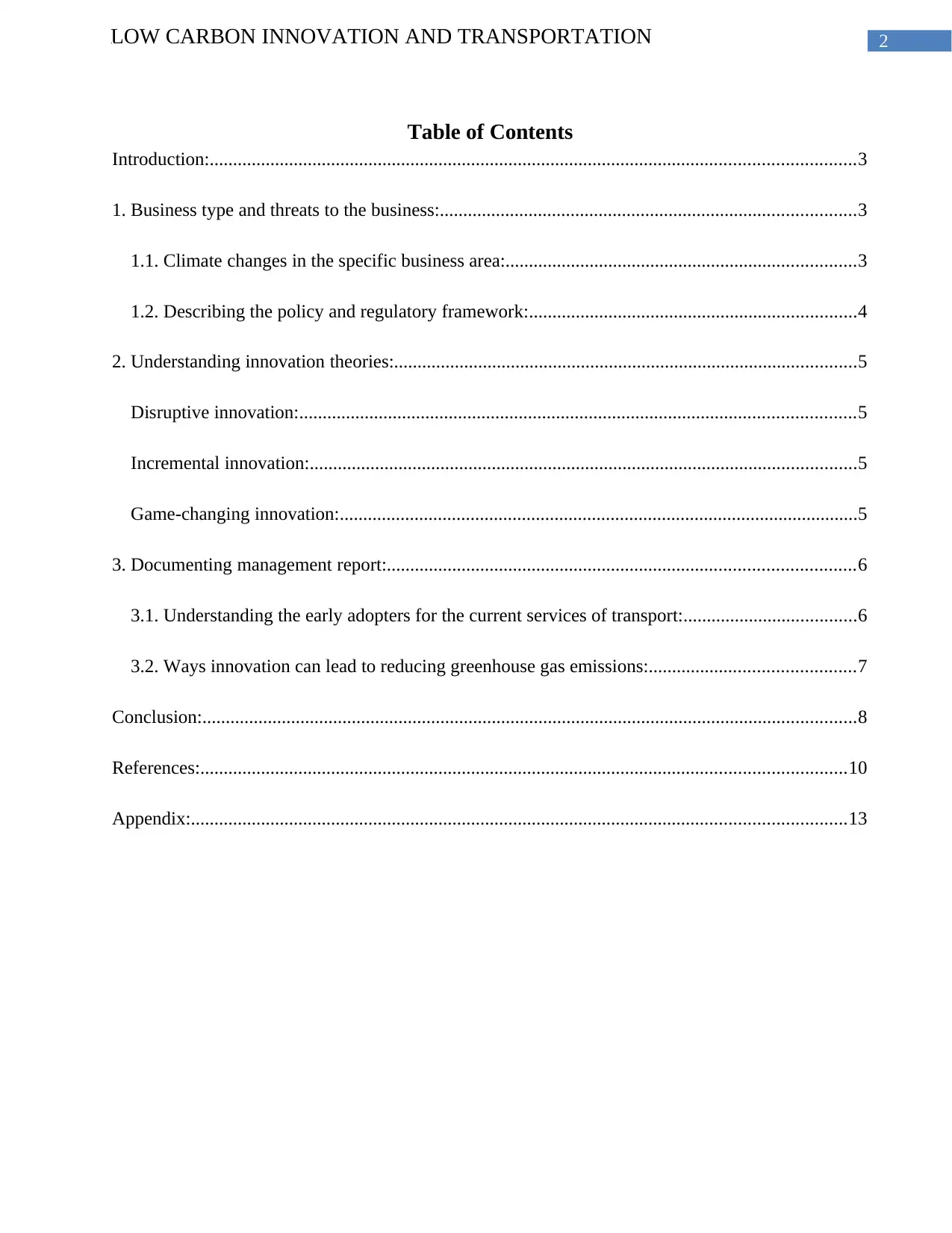
2LOW CARBON INNOVATION AND TRANSPORTATION
Table of Contents
Introduction:..........................................................................................................................................3
1. Business type and threats to the business:.........................................................................................3
1.1. Climate changes in the specific business area:...........................................................................3
1.2. Describing the policy and regulatory framework:......................................................................4
2. Understanding innovation theories:...................................................................................................5
Disruptive innovation:.......................................................................................................................5
Incremental innovation:.....................................................................................................................5
Game-changing innovation:...............................................................................................................5
3. Documenting management report:....................................................................................................6
3.1. Understanding the early adopters for the current services of transport:.....................................6
3.2. Ways innovation can lead to reducing greenhouse gas emissions:............................................7
Conclusion:............................................................................................................................................8
References:..........................................................................................................................................10
Appendix:............................................................................................................................................13
Table of Contents
Introduction:..........................................................................................................................................3
1. Business type and threats to the business:.........................................................................................3
1.1. Climate changes in the specific business area:...........................................................................3
1.2. Describing the policy and regulatory framework:......................................................................4
2. Understanding innovation theories:...................................................................................................5
Disruptive innovation:.......................................................................................................................5
Incremental innovation:.....................................................................................................................5
Game-changing innovation:...............................................................................................................5
3. Documenting management report:....................................................................................................6
3.1. Understanding the early adopters for the current services of transport:.....................................6
3.2. Ways innovation can lead to reducing greenhouse gas emissions:............................................7
Conclusion:............................................................................................................................................8
References:..........................................................................................................................................10
Appendix:............................................................................................................................................13
⊘ This is a preview!⊘
Do you want full access?
Subscribe today to unlock all pages.

Trusted by 1+ million students worldwide
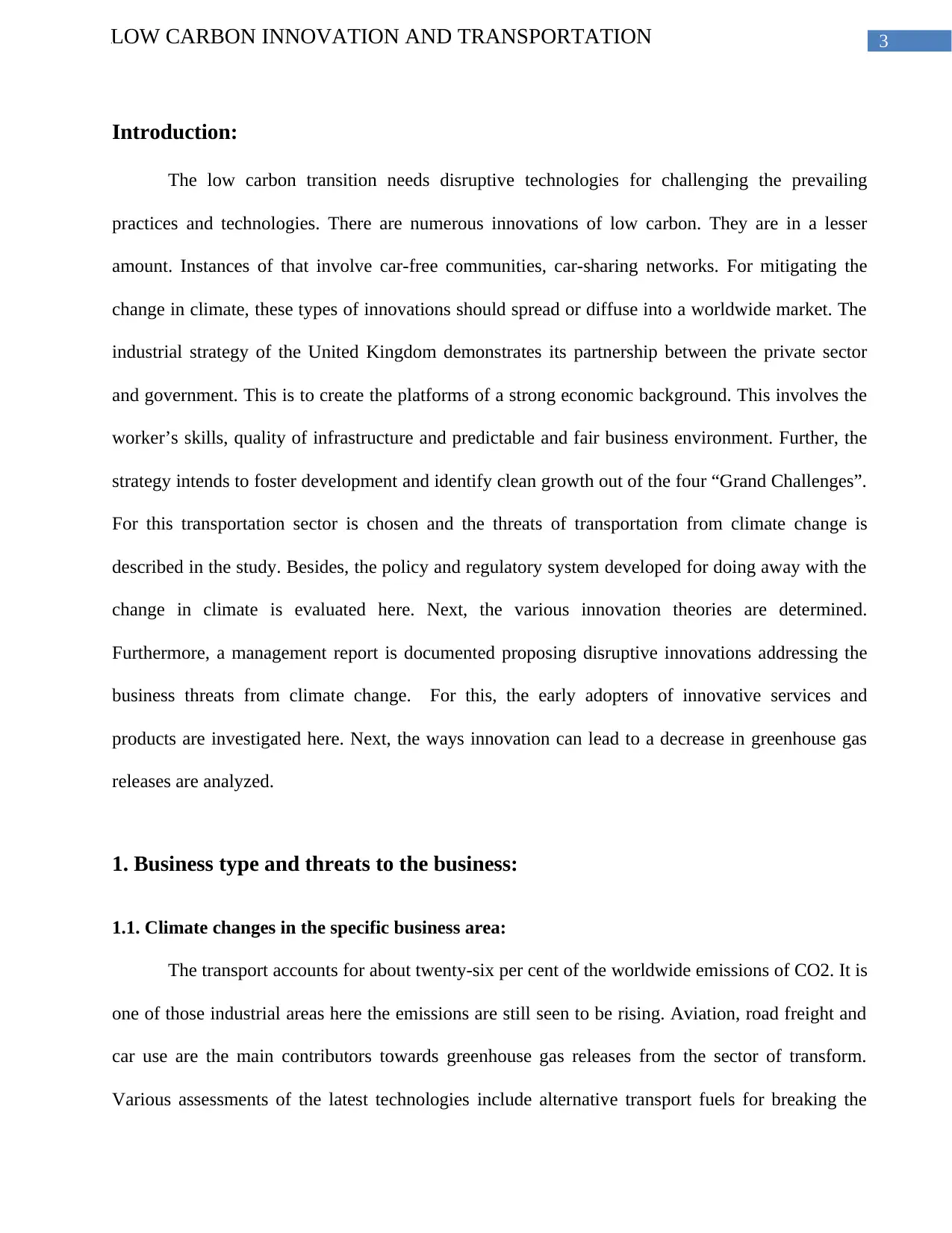
3LOW CARBON INNOVATION AND TRANSPORTATION
Introduction:
The low carbon transition needs disruptive technologies for challenging the prevailing
practices and technologies. There are numerous innovations of low carbon. They are in a lesser
amount. Instances of that involve car-free communities, car-sharing networks. For mitigating the
change in climate, these types of innovations should spread or diffuse into a worldwide market. The
industrial strategy of the United Kingdom demonstrates its partnership between the private sector
and government. This is to create the platforms of a strong economic background. This involves the
worker’s skills, quality of infrastructure and predictable and fair business environment. Further, the
strategy intends to foster development and identify clean growth out of the four “Grand Challenges”.
For this transportation sector is chosen and the threats of transportation from climate change is
described in the study. Besides, the policy and regulatory system developed for doing away with the
change in climate is evaluated here. Next, the various innovation theories are determined.
Furthermore, a management report is documented proposing disruptive innovations addressing the
business threats from climate change. For this, the early adopters of innovative services and
products are investigated here. Next, the ways innovation can lead to a decrease in greenhouse gas
releases are analyzed.
1. Business type and threats to the business:
1.1. Climate changes in the specific business area:
The transport accounts for about twenty-six per cent of the worldwide emissions of CO2. It is
one of those industrial areas here the emissions are still seen to be rising. Aviation, road freight and
car use are the main contributors towards greenhouse gas releases from the sector of transform.
Various assessments of the latest technologies include alternative transport fuels for breaking the
Introduction:
The low carbon transition needs disruptive technologies for challenging the prevailing
practices and technologies. There are numerous innovations of low carbon. They are in a lesser
amount. Instances of that involve car-free communities, car-sharing networks. For mitigating the
change in climate, these types of innovations should spread or diffuse into a worldwide market. The
industrial strategy of the United Kingdom demonstrates its partnership between the private sector
and government. This is to create the platforms of a strong economic background. This involves the
worker’s skills, quality of infrastructure and predictable and fair business environment. Further, the
strategy intends to foster development and identify clean growth out of the four “Grand Challenges”.
For this transportation sector is chosen and the threats of transportation from climate change is
described in the study. Besides, the policy and regulatory system developed for doing away with the
change in climate is evaluated here. Next, the various innovation theories are determined.
Furthermore, a management report is documented proposing disruptive innovations addressing the
business threats from climate change. For this, the early adopters of innovative services and
products are investigated here. Next, the ways innovation can lead to a decrease in greenhouse gas
releases are analyzed.
1. Business type and threats to the business:
1.1. Climate changes in the specific business area:
The transport accounts for about twenty-six per cent of the worldwide emissions of CO2. It is
one of those industrial areas here the emissions are still seen to be rising. Aviation, road freight and
car use are the main contributors towards greenhouse gas releases from the sector of transform.
Various assessments of the latest technologies include alternative transport fuels for breaking the
Paraphrase This Document
Need a fresh take? Get an instant paraphrase of this document with our AI Paraphraser
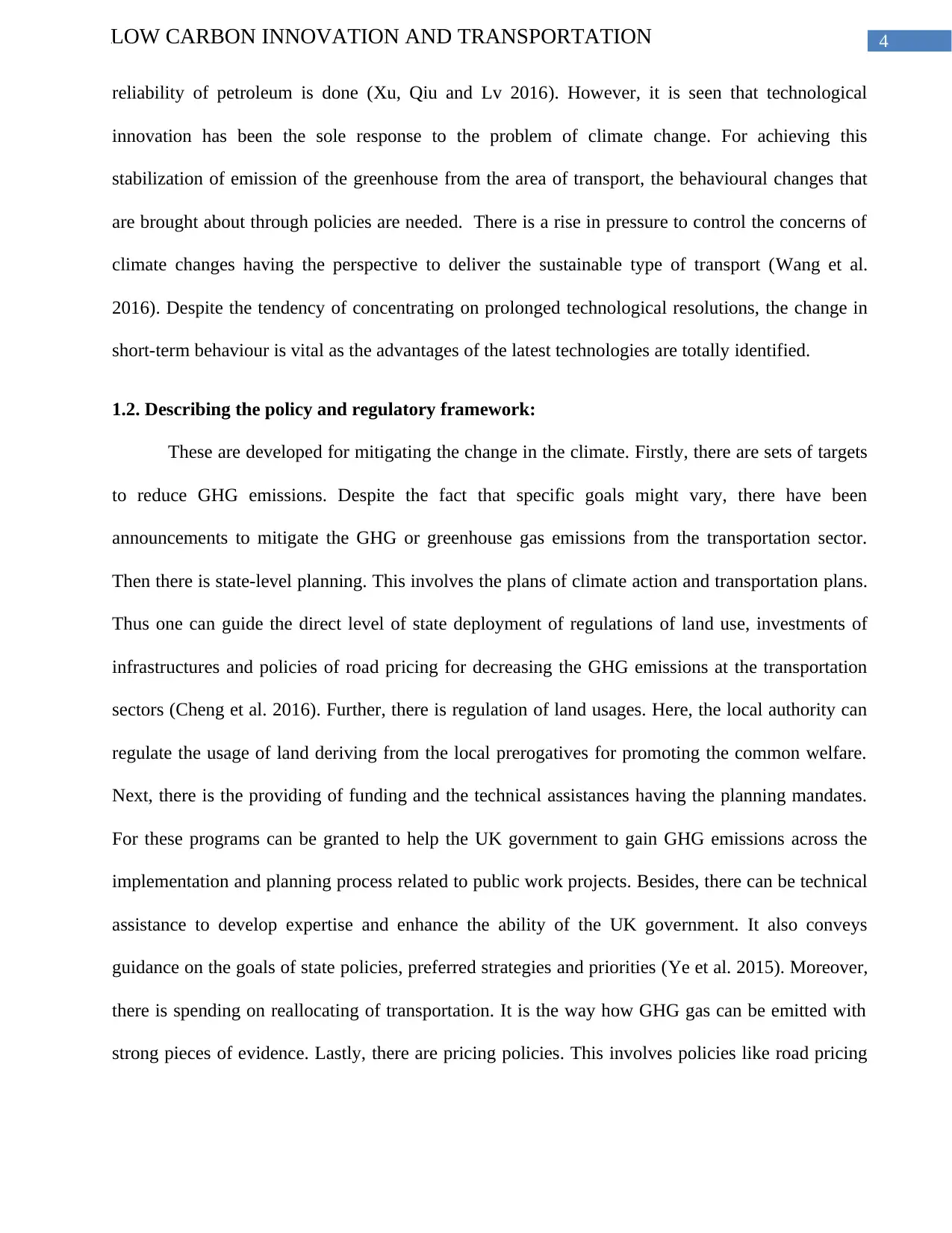
4LOW CARBON INNOVATION AND TRANSPORTATION
reliability of petroleum is done (Xu, Qiu and Lv 2016). However, it is seen that technological
innovation has been the sole response to the problem of climate change. For achieving this
stabilization of emission of the greenhouse from the area of transport, the behavioural changes that
are brought about through policies are needed. There is a rise in pressure to control the concerns of
climate changes having the perspective to deliver the sustainable type of transport (Wang et al.
2016). Despite the tendency of concentrating on prolonged technological resolutions, the change in
short-term behaviour is vital as the advantages of the latest technologies are totally identified.
1.2. Describing the policy and regulatory framework:
These are developed for mitigating the change in the climate. Firstly, there are sets of targets
to reduce GHG emissions. Despite the fact that specific goals might vary, there have been
announcements to mitigate the GHG or greenhouse gas emissions from the transportation sector.
Then there is state-level planning. This involves the plans of climate action and transportation plans.
Thus one can guide the direct level of state deployment of regulations of land use, investments of
infrastructures and policies of road pricing for decreasing the GHG emissions at the transportation
sectors (Cheng et al. 2016). Further, there is regulation of land usages. Here, the local authority can
regulate the usage of land deriving from the local prerogatives for promoting the common welfare.
Next, there is the providing of funding and the technical assistances having the planning mandates.
For these programs can be granted to help the UK government to gain GHG emissions across the
implementation and planning process related to public work projects. Besides, there can be technical
assistance to develop expertise and enhance the ability of the UK government. It also conveys
guidance on the goals of state policies, preferred strategies and priorities (Ye et al. 2015). Moreover,
there is spending on reallocating of transportation. It is the way how GHG gas can be emitted with
strong pieces of evidence. Lastly, there are pricing policies. This involves policies like road pricing
reliability of petroleum is done (Xu, Qiu and Lv 2016). However, it is seen that technological
innovation has been the sole response to the problem of climate change. For achieving this
stabilization of emission of the greenhouse from the area of transport, the behavioural changes that
are brought about through policies are needed. There is a rise in pressure to control the concerns of
climate changes having the perspective to deliver the sustainable type of transport (Wang et al.
2016). Despite the tendency of concentrating on prolonged technological resolutions, the change in
short-term behaviour is vital as the advantages of the latest technologies are totally identified.
1.2. Describing the policy and regulatory framework:
These are developed for mitigating the change in the climate. Firstly, there are sets of targets
to reduce GHG emissions. Despite the fact that specific goals might vary, there have been
announcements to mitigate the GHG or greenhouse gas emissions from the transportation sector.
Then there is state-level planning. This involves the plans of climate action and transportation plans.
Thus one can guide the direct level of state deployment of regulations of land use, investments of
infrastructures and policies of road pricing for decreasing the GHG emissions at the transportation
sectors (Cheng et al. 2016). Further, there is regulation of land usages. Here, the local authority can
regulate the usage of land deriving from the local prerogatives for promoting the common welfare.
Next, there is the providing of funding and the technical assistances having the planning mandates.
For these programs can be granted to help the UK government to gain GHG emissions across the
implementation and planning process related to public work projects. Besides, there can be technical
assistance to develop expertise and enhance the ability of the UK government. It also conveys
guidance on the goals of state policies, preferred strategies and priorities (Ye et al. 2015). Moreover,
there is spending on reallocating of transportation. It is the way how GHG gas can be emitted with
strong pieces of evidence. Lastly, there are pricing policies. This involves policies like road pricing
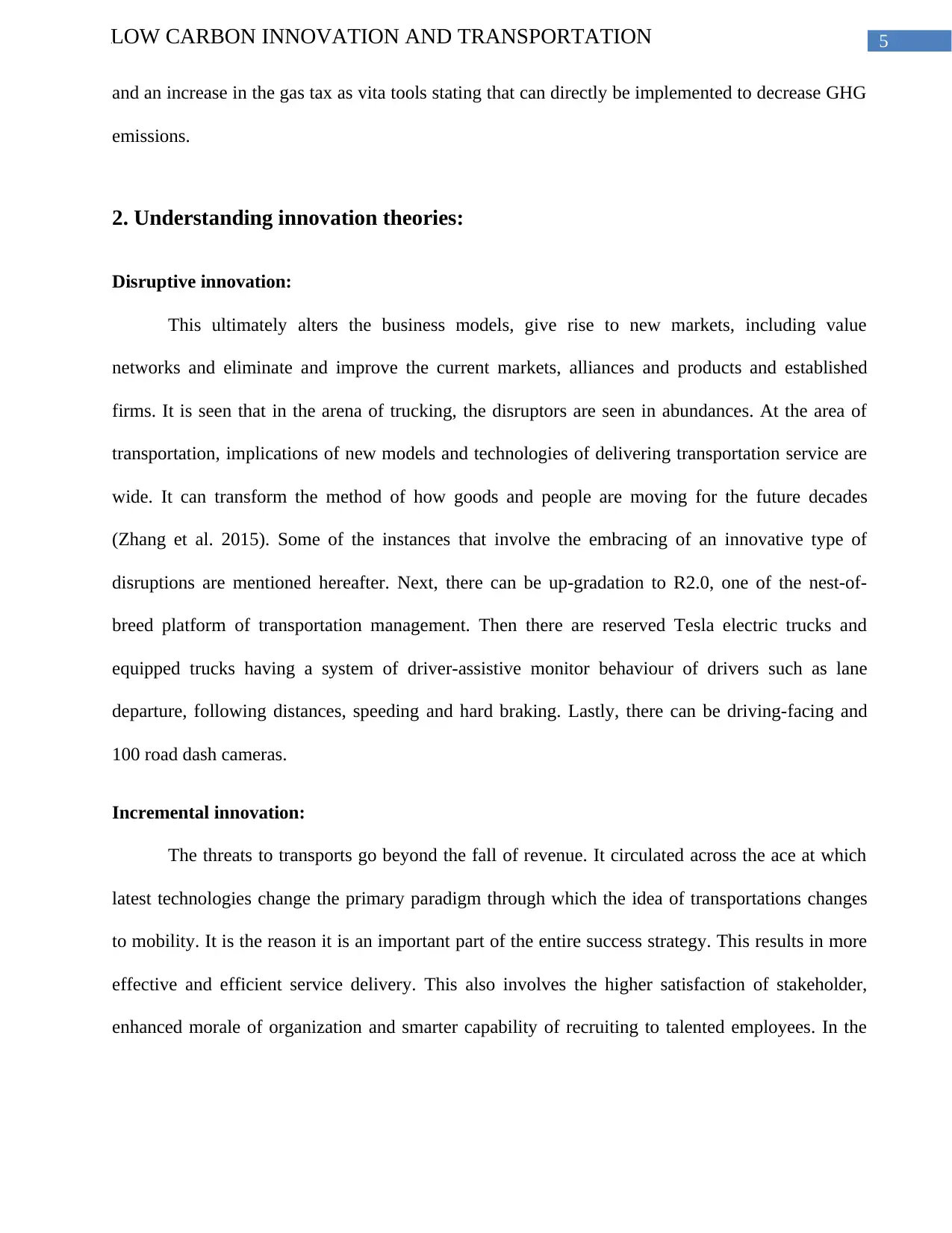
5LOW CARBON INNOVATION AND TRANSPORTATION
and an increase in the gas tax as vita tools stating that can directly be implemented to decrease GHG
emissions.
2. Understanding innovation theories:
Disruptive innovation:
This ultimately alters the business models, give rise to new markets, including value
networks and eliminate and improve the current markets, alliances and products and established
firms. It is seen that in the arena of trucking, the disruptors are seen in abundances. At the area of
transportation, implications of new models and technologies of delivering transportation service are
wide. It can transform the method of how goods and people are moving for the future decades
(Zhang et al. 2015). Some of the instances that involve the embracing of an innovative type of
disruptions are mentioned hereafter. Next, there can be up-gradation to R2.0, one of the nest-of-
breed platform of transportation management. Then there are reserved Tesla electric trucks and
equipped trucks having a system of driver-assistive monitor behaviour of drivers such as lane
departure, following distances, speeding and hard braking. Lastly, there can be driving-facing and
100 road dash cameras.
Incremental innovation:
The threats to transports go beyond the fall of revenue. It circulated across the ace at which
latest technologies change the primary paradigm through which the idea of transportations changes
to mobility. It is the reason it is an important part of the entire success strategy. This results in more
effective and efficient service delivery. This also involves the higher satisfaction of stakeholder,
enhanced morale of organization and smarter capability of recruiting to talented employees. In the
and an increase in the gas tax as vita tools stating that can directly be implemented to decrease GHG
emissions.
2. Understanding innovation theories:
Disruptive innovation:
This ultimately alters the business models, give rise to new markets, including value
networks and eliminate and improve the current markets, alliances and products and established
firms. It is seen that in the arena of trucking, the disruptors are seen in abundances. At the area of
transportation, implications of new models and technologies of delivering transportation service are
wide. It can transform the method of how goods and people are moving for the future decades
(Zhang et al. 2015). Some of the instances that involve the embracing of an innovative type of
disruptions are mentioned hereafter. Next, there can be up-gradation to R2.0, one of the nest-of-
breed platform of transportation management. Then there are reserved Tesla electric trucks and
equipped trucks having a system of driver-assistive monitor behaviour of drivers such as lane
departure, following distances, speeding and hard braking. Lastly, there can be driving-facing and
100 road dash cameras.
Incremental innovation:
The threats to transports go beyond the fall of revenue. It circulated across the ace at which
latest technologies change the primary paradigm through which the idea of transportations changes
to mobility. It is the reason it is an important part of the entire success strategy. This results in more
effective and efficient service delivery. This also involves the higher satisfaction of stakeholder,
enhanced morale of organization and smarter capability of recruiting to talented employees. In the
⊘ This is a preview!⊘
Do you want full access?
Subscribe today to unlock all pages.

Trusted by 1+ million students worldwide
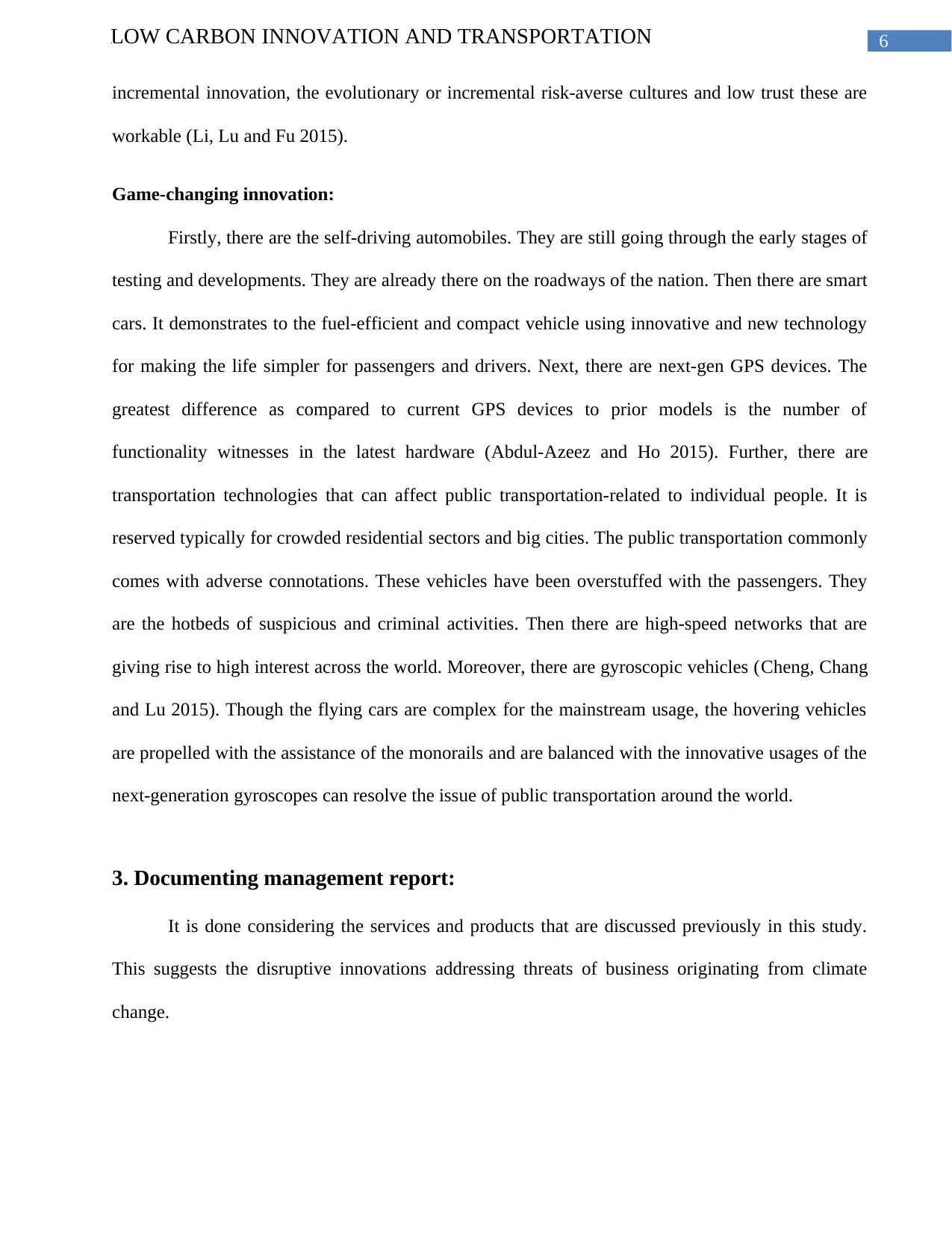
6LOW CARBON INNOVATION AND TRANSPORTATION
incremental innovation, the evolutionary or incremental risk-averse cultures and low trust these are
workable (Li, Lu and Fu 2015).
Game-changing innovation:
Firstly, there are the self-driving automobiles. They are still going through the early stages of
testing and developments. They are already there on the roadways of the nation. Then there are smart
cars. It demonstrates to the fuel-efficient and compact vehicle using innovative and new technology
for making the life simpler for passengers and drivers. Next, there are next-gen GPS devices. The
greatest difference as compared to current GPS devices to prior models is the number of
functionality witnesses in the latest hardware (Abdul-Azeez and Ho 2015). Further, there are
transportation technologies that can affect public transportation-related to individual people. It is
reserved typically for crowded residential sectors and big cities. The public transportation commonly
comes with adverse connotations. These vehicles have been overstuffed with the passengers. They
are the hotbeds of suspicious and criminal activities. Then there are high-speed networks that are
giving rise to high interest across the world. Moreover, there are gyroscopic vehicles (Cheng, Chang
and Lu 2015). Though the flying cars are complex for the mainstream usage, the hovering vehicles
are propelled with the assistance of the monorails and are balanced with the innovative usages of the
next-generation gyroscopes can resolve the issue of public transportation around the world.
3. Documenting management report:
It is done considering the services and products that are discussed previously in this study.
This suggests the disruptive innovations addressing threats of business originating from climate
change.
incremental innovation, the evolutionary or incremental risk-averse cultures and low trust these are
workable (Li, Lu and Fu 2015).
Game-changing innovation:
Firstly, there are the self-driving automobiles. They are still going through the early stages of
testing and developments. They are already there on the roadways of the nation. Then there are smart
cars. It demonstrates to the fuel-efficient and compact vehicle using innovative and new technology
for making the life simpler for passengers and drivers. Next, there are next-gen GPS devices. The
greatest difference as compared to current GPS devices to prior models is the number of
functionality witnesses in the latest hardware (Abdul-Azeez and Ho 2015). Further, there are
transportation technologies that can affect public transportation-related to individual people. It is
reserved typically for crowded residential sectors and big cities. The public transportation commonly
comes with adverse connotations. These vehicles have been overstuffed with the passengers. They
are the hotbeds of suspicious and criminal activities. Then there are high-speed networks that are
giving rise to high interest across the world. Moreover, there are gyroscopic vehicles (Cheng, Chang
and Lu 2015). Though the flying cars are complex for the mainstream usage, the hovering vehicles
are propelled with the assistance of the monorails and are balanced with the innovative usages of the
next-generation gyroscopes can resolve the issue of public transportation around the world.
3. Documenting management report:
It is done considering the services and products that are discussed previously in this study.
This suggests the disruptive innovations addressing threats of business originating from climate
change.
Paraphrase This Document
Need a fresh take? Get an instant paraphrase of this document with our AI Paraphraser
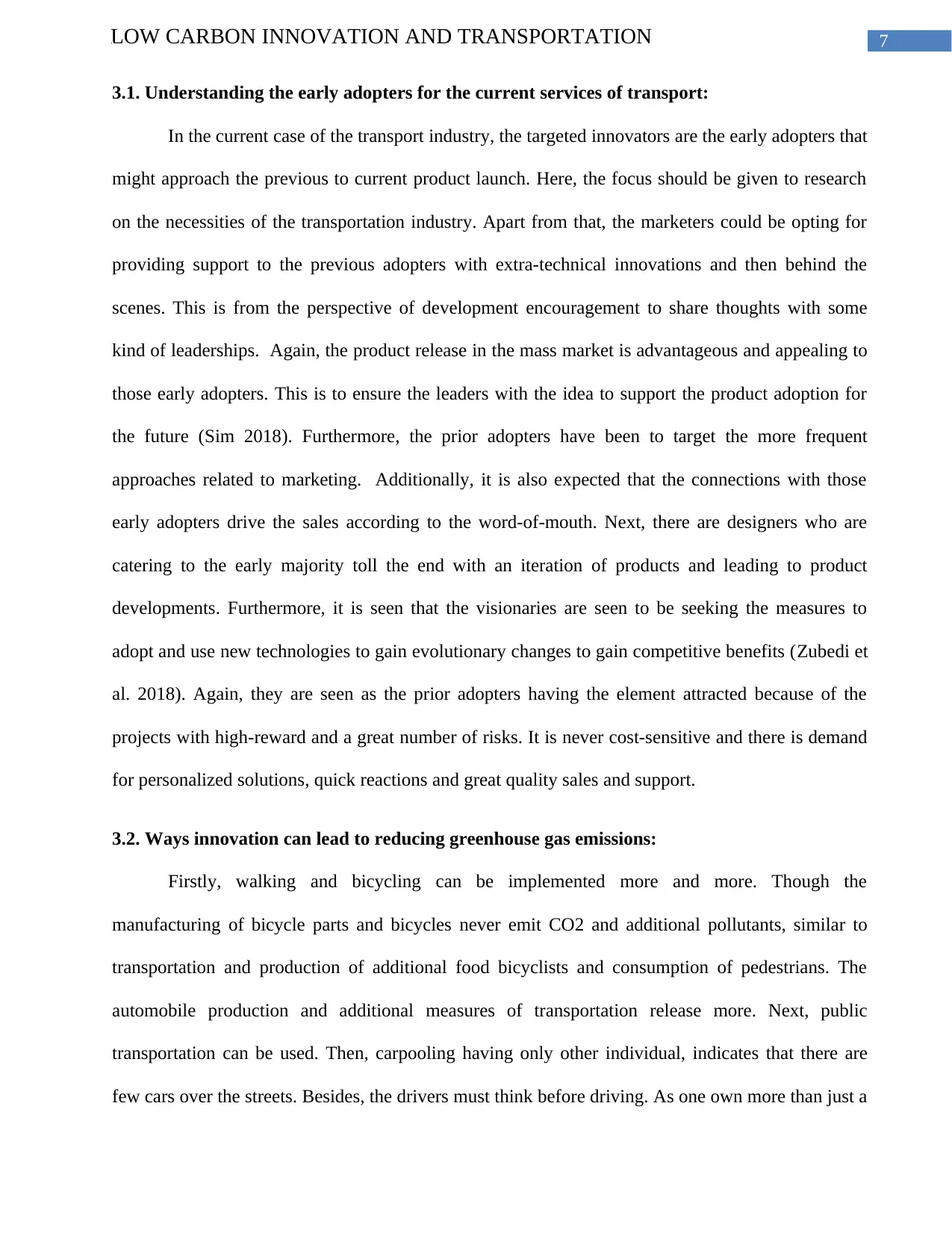
7LOW CARBON INNOVATION AND TRANSPORTATION
3.1. Understanding the early adopters for the current services of transport:
In the current case of the transport industry, the targeted innovators are the early adopters that
might approach the previous to current product launch. Here, the focus should be given to research
on the necessities of the transportation industry. Apart from that, the marketers could be opting for
providing support to the previous adopters with extra-technical innovations and then behind the
scenes. This is from the perspective of development encouragement to share thoughts with some
kind of leaderships. Again, the product release in the mass market is advantageous and appealing to
those early adopters. This is to ensure the leaders with the idea to support the product adoption for
the future (Sim 2018). Furthermore, the prior adopters have been to target the more frequent
approaches related to marketing. Additionally, it is also expected that the connections with those
early adopters drive the sales according to the word-of-mouth. Next, there are designers who are
catering to the early majority toll the end with an iteration of products and leading to product
developments. Furthermore, it is seen that the visionaries are seen to be seeking the measures to
adopt and use new technologies to gain evolutionary changes to gain competitive benefits (Zubedi et
al. 2018). Again, they are seen as the prior adopters having the element attracted because of the
projects with high-reward and a great number of risks. It is never cost-sensitive and there is demand
for personalized solutions, quick reactions and great quality sales and support.
3.2. Ways innovation can lead to reducing greenhouse gas emissions:
Firstly, walking and bicycling can be implemented more and more. Though the
manufacturing of bicycle parts and bicycles never emit CO2 and additional pollutants, similar to
transportation and production of additional food bicyclists and consumption of pedestrians. The
automobile production and additional measures of transportation release more. Next, public
transportation can be used. Then, carpooling having only other individual, indicates that there are
few cars over the streets. Besides, the drivers must think before driving. As one own more than just a
3.1. Understanding the early adopters for the current services of transport:
In the current case of the transport industry, the targeted innovators are the early adopters that
might approach the previous to current product launch. Here, the focus should be given to research
on the necessities of the transportation industry. Apart from that, the marketers could be opting for
providing support to the previous adopters with extra-technical innovations and then behind the
scenes. This is from the perspective of development encouragement to share thoughts with some
kind of leaderships. Again, the product release in the mass market is advantageous and appealing to
those early adopters. This is to ensure the leaders with the idea to support the product adoption for
the future (Sim 2018). Furthermore, the prior adopters have been to target the more frequent
approaches related to marketing. Additionally, it is also expected that the connections with those
early adopters drive the sales according to the word-of-mouth. Next, there are designers who are
catering to the early majority toll the end with an iteration of products and leading to product
developments. Furthermore, it is seen that the visionaries are seen to be seeking the measures to
adopt and use new technologies to gain evolutionary changes to gain competitive benefits (Zubedi et
al. 2018). Again, they are seen as the prior adopters having the element attracted because of the
projects with high-reward and a great number of risks. It is never cost-sensitive and there is demand
for personalized solutions, quick reactions and great quality sales and support.
3.2. Ways innovation can lead to reducing greenhouse gas emissions:
Firstly, walking and bicycling can be implemented more and more. Though the
manufacturing of bicycle parts and bicycles never emit CO2 and additional pollutants, similar to
transportation and production of additional food bicyclists and consumption of pedestrians. The
automobile production and additional measures of transportation release more. Next, public
transportation can be used. Then, carpooling having only other individual, indicates that there are
few cars over the streets. Besides, the drivers must think before driving. As one own more than just a
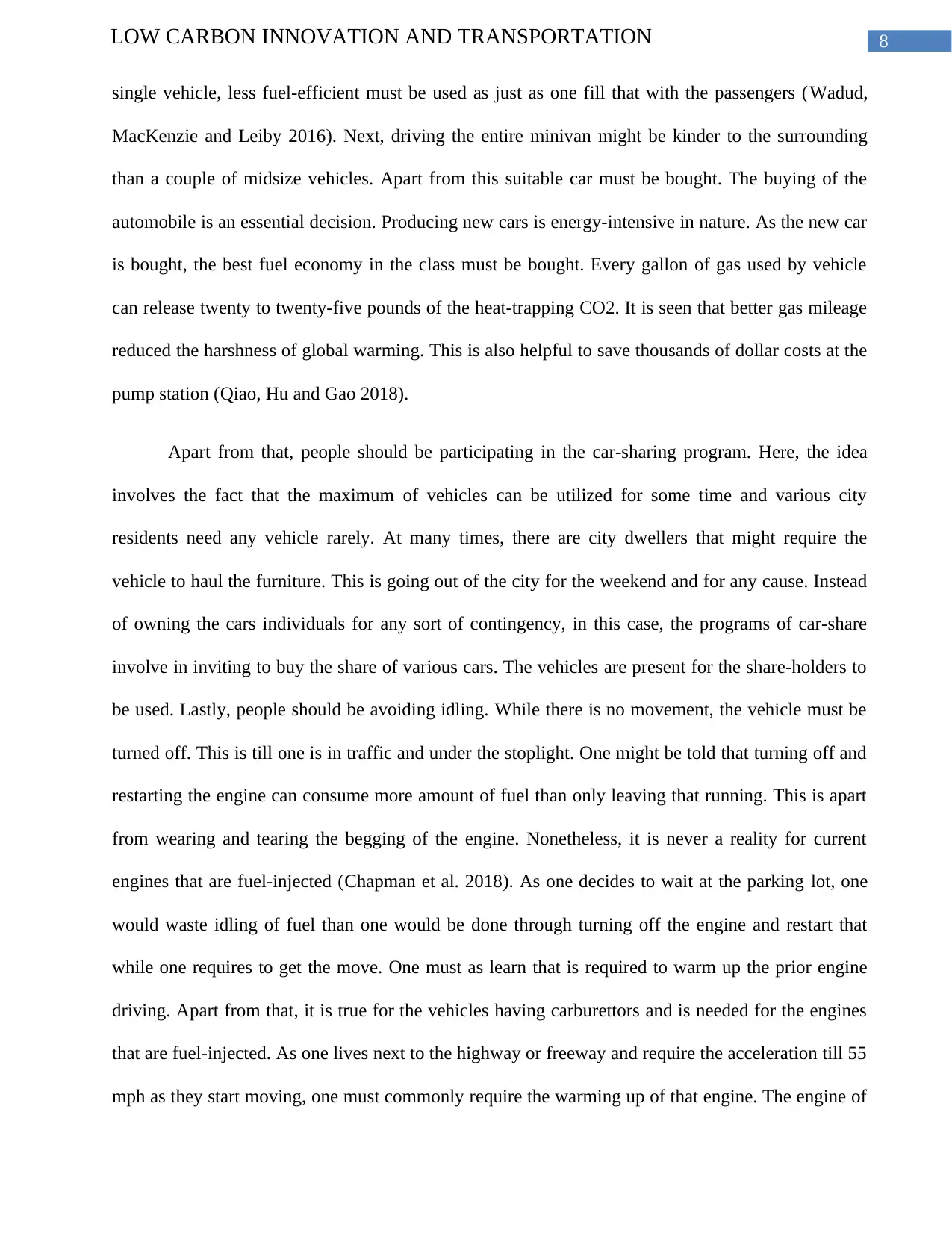
8LOW CARBON INNOVATION AND TRANSPORTATION
single vehicle, less fuel-efficient must be used as just as one fill that with the passengers (Wadud,
MacKenzie and Leiby 2016). Next, driving the entire minivan might be kinder to the surrounding
than a couple of midsize vehicles. Apart from this suitable car must be bought. The buying of the
automobile is an essential decision. Producing new cars is energy-intensive in nature. As the new car
is bought, the best fuel economy in the class must be bought. Every gallon of gas used by vehicle
can release twenty to twenty-five pounds of the heat-trapping CO2. It is seen that better gas mileage
reduced the harshness of global warming. This is also helpful to save thousands of dollar costs at the
pump station (Qiao, Hu and Gao 2018).
Apart from that, people should be participating in the car-sharing program. Here, the idea
involves the fact that the maximum of vehicles can be utilized for some time and various city
residents need any vehicle rarely. At many times, there are city dwellers that might require the
vehicle to haul the furniture. This is going out of the city for the weekend and for any cause. Instead
of owning the cars individuals for any sort of contingency, in this case, the programs of car-share
involve in inviting to buy the share of various cars. The vehicles are present for the share-holders to
be used. Lastly, people should be avoiding idling. While there is no movement, the vehicle must be
turned off. This is till one is in traffic and under the stoplight. One might be told that turning off and
restarting the engine can consume more amount of fuel than only leaving that running. This is apart
from wearing and tearing the begging of the engine. Nonetheless, it is never a reality for current
engines that are fuel-injected (Chapman et al. 2018). As one decides to wait at the parking lot, one
would waste idling of fuel than one would be done through turning off the engine and restart that
while one requires to get the move. One must as learn that is required to warm up the prior engine
driving. Apart from that, it is true for the vehicles having carburettors and is needed for the engines
that are fuel-injected. As one lives next to the highway or freeway and require the acceleration till 55
mph as they start moving, one must commonly require the warming up of that engine. The engine of
single vehicle, less fuel-efficient must be used as just as one fill that with the passengers (Wadud,
MacKenzie and Leiby 2016). Next, driving the entire minivan might be kinder to the surrounding
than a couple of midsize vehicles. Apart from this suitable car must be bought. The buying of the
automobile is an essential decision. Producing new cars is energy-intensive in nature. As the new car
is bought, the best fuel economy in the class must be bought. Every gallon of gas used by vehicle
can release twenty to twenty-five pounds of the heat-trapping CO2. It is seen that better gas mileage
reduced the harshness of global warming. This is also helpful to save thousands of dollar costs at the
pump station (Qiao, Hu and Gao 2018).
Apart from that, people should be participating in the car-sharing program. Here, the idea
involves the fact that the maximum of vehicles can be utilized for some time and various city
residents need any vehicle rarely. At many times, there are city dwellers that might require the
vehicle to haul the furniture. This is going out of the city for the weekend and for any cause. Instead
of owning the cars individuals for any sort of contingency, in this case, the programs of car-share
involve in inviting to buy the share of various cars. The vehicles are present for the share-holders to
be used. Lastly, people should be avoiding idling. While there is no movement, the vehicle must be
turned off. This is till one is in traffic and under the stoplight. One might be told that turning off and
restarting the engine can consume more amount of fuel than only leaving that running. This is apart
from wearing and tearing the begging of the engine. Nonetheless, it is never a reality for current
engines that are fuel-injected (Chapman et al. 2018). As one decides to wait at the parking lot, one
would waste idling of fuel than one would be done through turning off the engine and restart that
while one requires to get the move. One must as learn that is required to warm up the prior engine
driving. Apart from that, it is true for the vehicles having carburettors and is needed for the engines
that are fuel-injected. As one lives next to the highway or freeway and require the acceleration till 55
mph as they start moving, one must commonly require the warming up of that engine. The engine of
⊘ This is a preview!⊘
Do you want full access?
Subscribe today to unlock all pages.

Trusted by 1+ million students worldwide
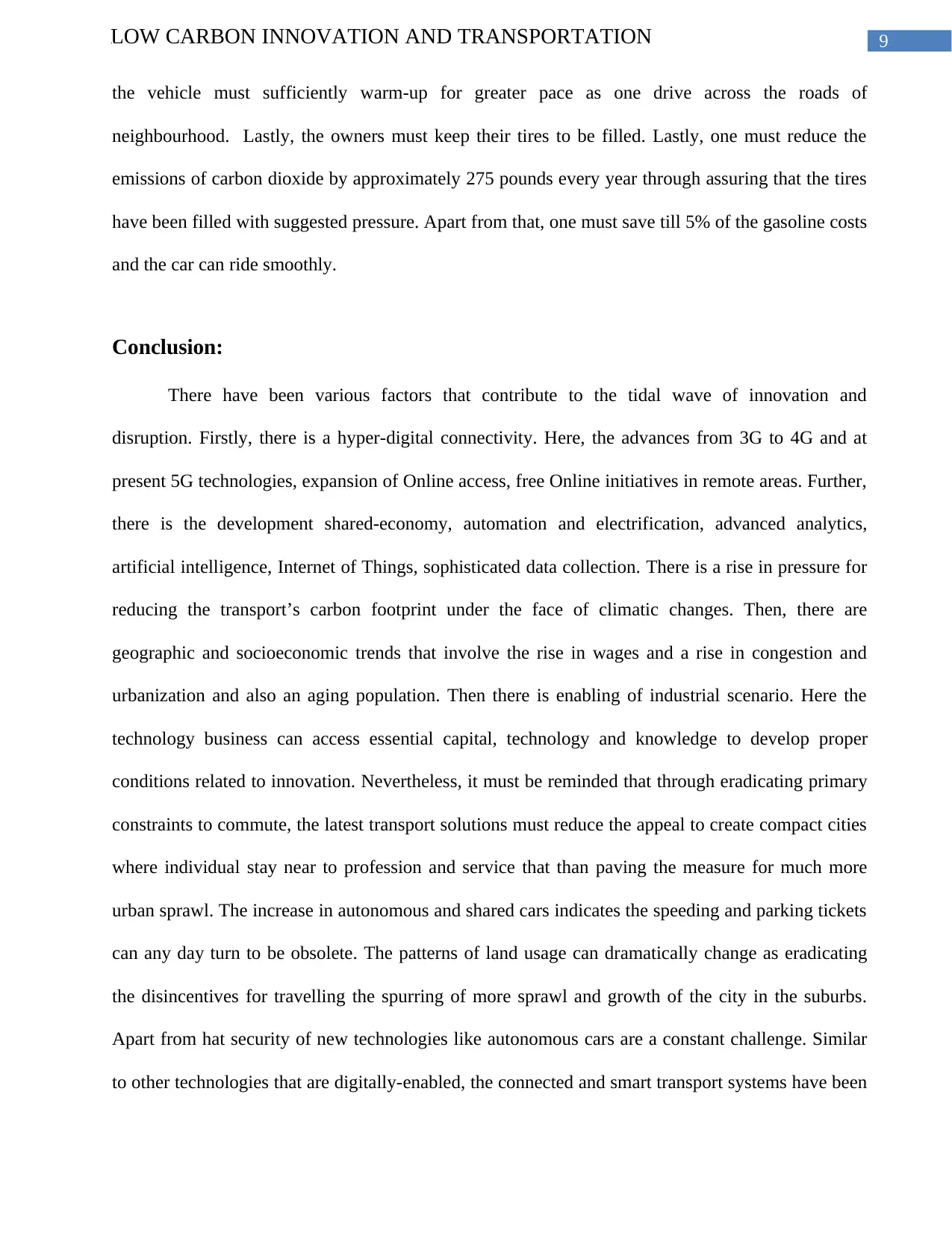
9LOW CARBON INNOVATION AND TRANSPORTATION
the vehicle must sufficiently warm-up for greater pace as one drive across the roads of
neighbourhood. Lastly, the owners must keep their tires to be filled. Lastly, one must reduce the
emissions of carbon dioxide by approximately 275 pounds every year through assuring that the tires
have been filled with suggested pressure. Apart from that, one must save till 5% of the gasoline costs
and the car can ride smoothly.
Conclusion:
There have been various factors that contribute to the tidal wave of innovation and
disruption. Firstly, there is a hyper-digital connectivity. Here, the advances from 3G to 4G and at
present 5G technologies, expansion of Online access, free Online initiatives in remote areas. Further,
there is the development shared-economy, automation and electrification, advanced analytics,
artificial intelligence, Internet of Things, sophisticated data collection. There is a rise in pressure for
reducing the transport’s carbon footprint under the face of climatic changes. Then, there are
geographic and socioeconomic trends that involve the rise in wages and a rise in congestion and
urbanization and also an aging population. Then there is enabling of industrial scenario. Here the
technology business can access essential capital, technology and knowledge to develop proper
conditions related to innovation. Nevertheless, it must be reminded that through eradicating primary
constraints to commute, the latest transport solutions must reduce the appeal to create compact cities
where individual stay near to profession and service that than paving the measure for much more
urban sprawl. The increase in autonomous and shared cars indicates the speeding and parking tickets
can any day turn to be obsolete. The patterns of land usage can dramatically change as eradicating
the disincentives for travelling the spurring of more sprawl and growth of the city in the suburbs.
Apart from hat security of new technologies like autonomous cars are a constant challenge. Similar
to other technologies that are digitally-enabled, the connected and smart transport systems have been
the vehicle must sufficiently warm-up for greater pace as one drive across the roads of
neighbourhood. Lastly, the owners must keep their tires to be filled. Lastly, one must reduce the
emissions of carbon dioxide by approximately 275 pounds every year through assuring that the tires
have been filled with suggested pressure. Apart from that, one must save till 5% of the gasoline costs
and the car can ride smoothly.
Conclusion:
There have been various factors that contribute to the tidal wave of innovation and
disruption. Firstly, there is a hyper-digital connectivity. Here, the advances from 3G to 4G and at
present 5G technologies, expansion of Online access, free Online initiatives in remote areas. Further,
there is the development shared-economy, automation and electrification, advanced analytics,
artificial intelligence, Internet of Things, sophisticated data collection. There is a rise in pressure for
reducing the transport’s carbon footprint under the face of climatic changes. Then, there are
geographic and socioeconomic trends that involve the rise in wages and a rise in congestion and
urbanization and also an aging population. Then there is enabling of industrial scenario. Here the
technology business can access essential capital, technology and knowledge to develop proper
conditions related to innovation. Nevertheless, it must be reminded that through eradicating primary
constraints to commute, the latest transport solutions must reduce the appeal to create compact cities
where individual stay near to profession and service that than paving the measure for much more
urban sprawl. The increase in autonomous and shared cars indicates the speeding and parking tickets
can any day turn to be obsolete. The patterns of land usage can dramatically change as eradicating
the disincentives for travelling the spurring of more sprawl and growth of the city in the suburbs.
Apart from hat security of new technologies like autonomous cars are a constant challenge. Similar
to other technologies that are digitally-enabled, the connected and smart transport systems have been
Paraphrase This Document
Need a fresh take? Get an instant paraphrase of this document with our AI Paraphraser
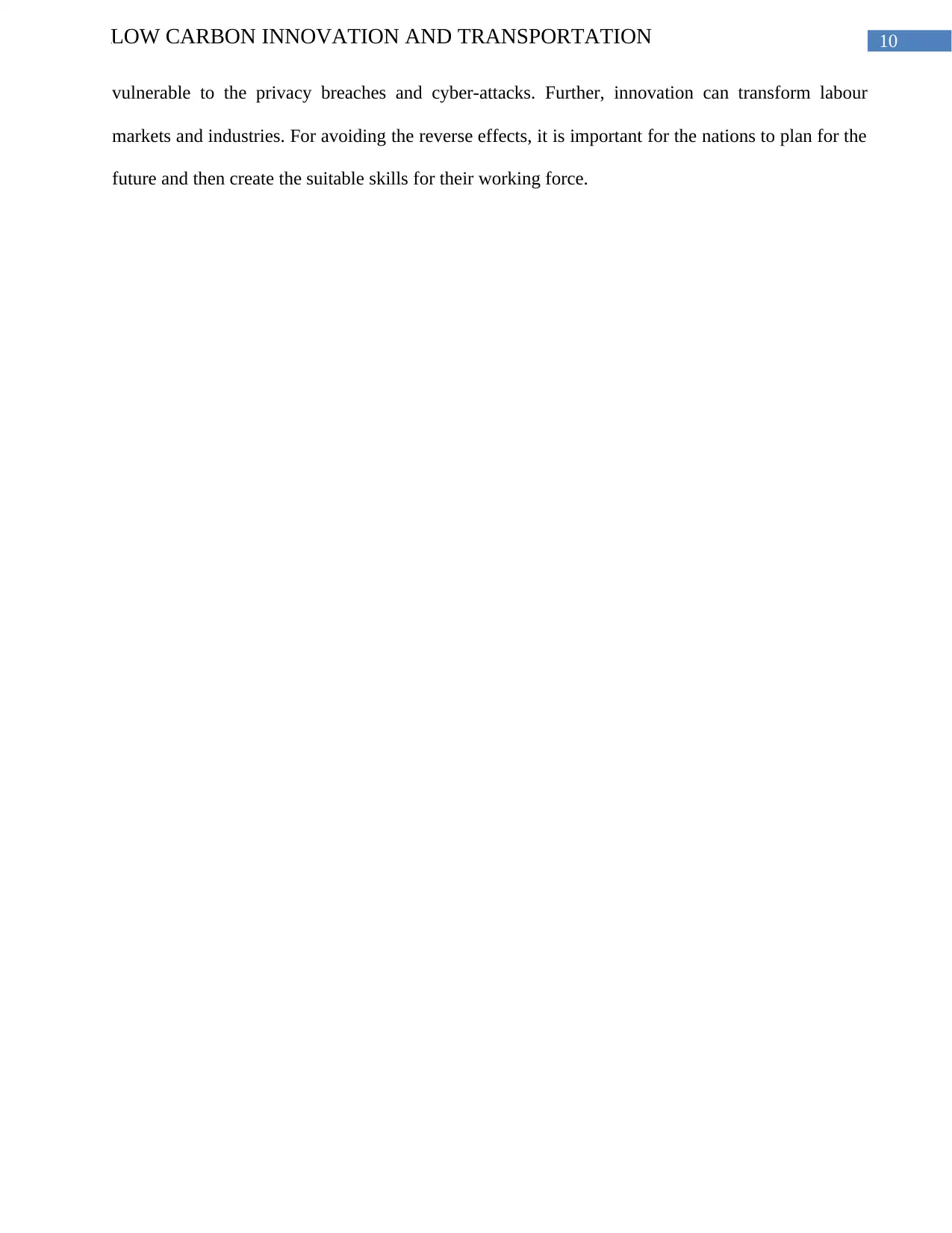
10LOW CARBON INNOVATION AND TRANSPORTATION
vulnerable to the privacy breaches and cyber-attacks. Further, innovation can transform labour
markets and industries. For avoiding the reverse effects, it is important for the nations to plan for the
future and then create the suitable skills for their working force.
vulnerable to the privacy breaches and cyber-attacks. Further, innovation can transform labour
markets and industries. For avoiding the reverse effects, it is important for the nations to plan for the
future and then create the suitable skills for their working force.
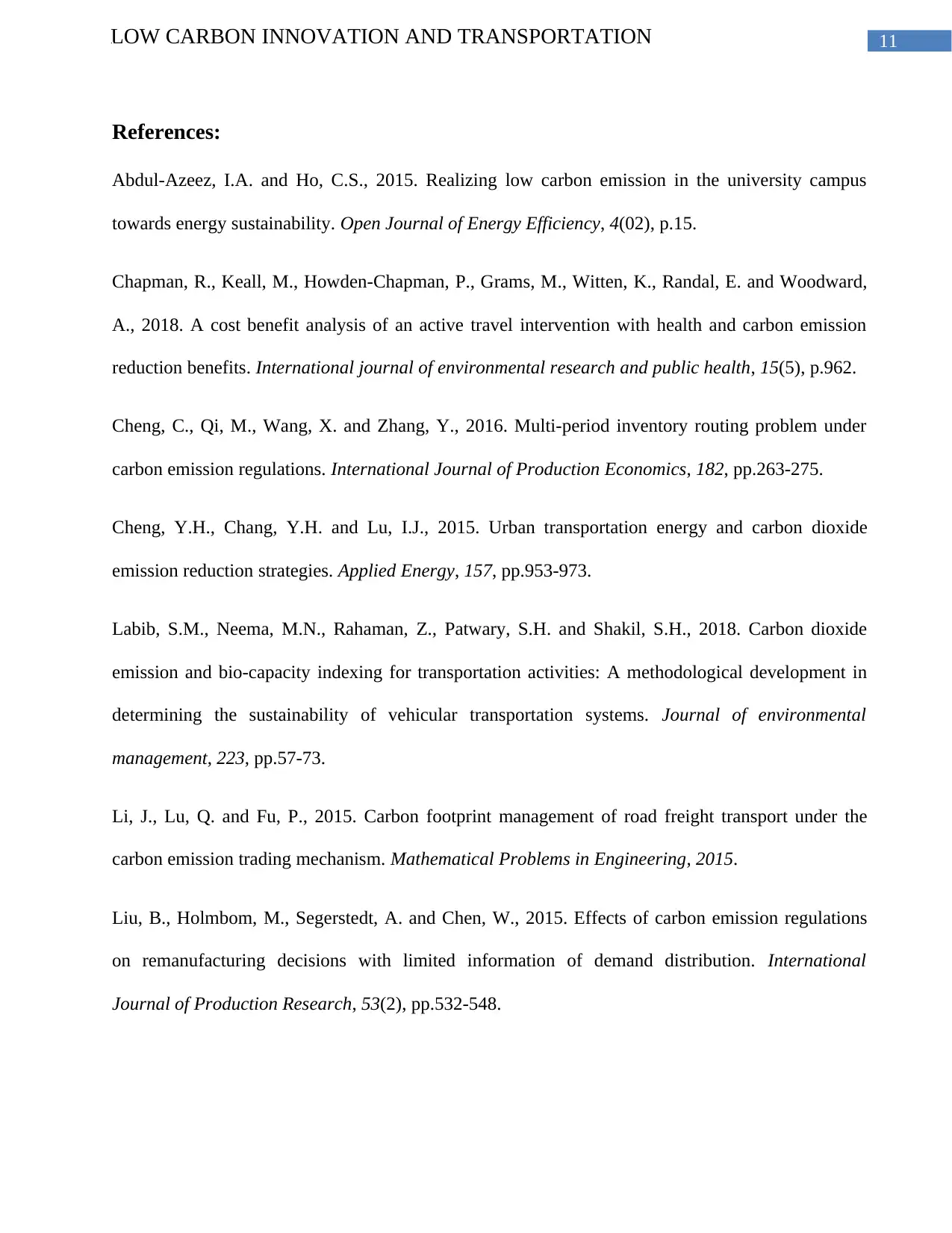
11LOW CARBON INNOVATION AND TRANSPORTATION
References:
Abdul-Azeez, I.A. and Ho, C.S., 2015. Realizing low carbon emission in the university campus
towards energy sustainability. Open Journal of Energy Efficiency, 4(02), p.15.
Chapman, R., Keall, M., Howden-Chapman, P., Grams, M., Witten, K., Randal, E. and Woodward,
A., 2018. A cost benefit analysis of an active travel intervention with health and carbon emission
reduction benefits. International journal of environmental research and public health, 15(5), p.962.
Cheng, C., Qi, M., Wang, X. and Zhang, Y., 2016. Multi-period inventory routing problem under
carbon emission regulations. International Journal of Production Economics, 182, pp.263-275.
Cheng, Y.H., Chang, Y.H. and Lu, I.J., 2015. Urban transportation energy and carbon dioxide
emission reduction strategies. Applied Energy, 157, pp.953-973.
Labib, S.M., Neema, M.N., Rahaman, Z., Patwary, S.H. and Shakil, S.H., 2018. Carbon dioxide
emission and bio-capacity indexing for transportation activities: A methodological development in
determining the sustainability of vehicular transportation systems. Journal of environmental
management, 223, pp.57-73.
Li, J., Lu, Q. and Fu, P., 2015. Carbon footprint management of road freight transport under the
carbon emission trading mechanism. Mathematical Problems in Engineering, 2015.
Liu, B., Holmbom, M., Segerstedt, A. and Chen, W., 2015. Effects of carbon emission regulations
on remanufacturing decisions with limited information of demand distribution. International
Journal of Production Research, 53(2), pp.532-548.
References:
Abdul-Azeez, I.A. and Ho, C.S., 2015. Realizing low carbon emission in the university campus
towards energy sustainability. Open Journal of Energy Efficiency, 4(02), p.15.
Chapman, R., Keall, M., Howden-Chapman, P., Grams, M., Witten, K., Randal, E. and Woodward,
A., 2018. A cost benefit analysis of an active travel intervention with health and carbon emission
reduction benefits. International journal of environmental research and public health, 15(5), p.962.
Cheng, C., Qi, M., Wang, X. and Zhang, Y., 2016. Multi-period inventory routing problem under
carbon emission regulations. International Journal of Production Economics, 182, pp.263-275.
Cheng, Y.H., Chang, Y.H. and Lu, I.J., 2015. Urban transportation energy and carbon dioxide
emission reduction strategies. Applied Energy, 157, pp.953-973.
Labib, S.M., Neema, M.N., Rahaman, Z., Patwary, S.H. and Shakil, S.H., 2018. Carbon dioxide
emission and bio-capacity indexing for transportation activities: A methodological development in
determining the sustainability of vehicular transportation systems. Journal of environmental
management, 223, pp.57-73.
Li, J., Lu, Q. and Fu, P., 2015. Carbon footprint management of road freight transport under the
carbon emission trading mechanism. Mathematical Problems in Engineering, 2015.
Liu, B., Holmbom, M., Segerstedt, A. and Chen, W., 2015. Effects of carbon emission regulations
on remanufacturing decisions with limited information of demand distribution. International
Journal of Production Research, 53(2), pp.532-548.
⊘ This is a preview!⊘
Do you want full access?
Subscribe today to unlock all pages.

Trusted by 1+ million students worldwide
1 out of 18
Related Documents
Your All-in-One AI-Powered Toolkit for Academic Success.
+13062052269
info@desklib.com
Available 24*7 on WhatsApp / Email
![[object Object]](/_next/static/media/star-bottom.7253800d.svg)
Unlock your academic potential
Copyright © 2020–2025 A2Z Services. All Rights Reserved. Developed and managed by ZUCOL.





